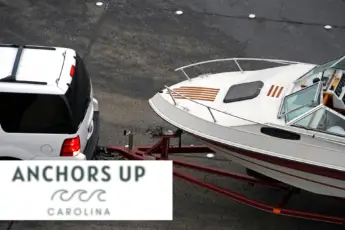One of the most important pieces of equipment aboard a boat is the anchor. The anchor is critical in holding the boat’s position when not in operation away from the dock. As a captain, I have anchored vessels ranging in size between 12 and 172 feet. However, some recreation boaters who have an anchor pulpit fail to properly secure the boat anchor. Without question, a loose anchor is dangerous. Understand the dangers of an unsecured boat anchor.
How Anchors Become Unsecured
There is one primary reason that anchors become loose while the boat is underway. In nearly every situation the operator of the boat or passenger fails to properly secure it in place.
Importantly, the anchor chain is secured in a multitude of ways depending on the design of the vessel. However, the chain must be manually secured into position in most situations to avoid it from falling free and bouncing in the waves. Often, the operator realizes the issue until it is to late and the anchor begins to deploy.
The Dangers Of An Unsecured Boat Anchor
Without question, there are numerous dangers of a boat anchor being left unsecured. Here are the primary dangers to be aware of if your anchor falls free from the pulpit while you’re underway.
Damage To The Boat
It should be noted that the primary concern with a loss of an anchor is the fact that it causes damage to the boat.
An anchor that has come loose is likely to swing and strike the hull, bounce at the water line and hit the bow, or come in contact with the propeller if you’re moving at high rates of speed. In any of these circumstances, you’re likely to have to repair the vessel.
Loss Of The Anchor
Importantly, anchor lines and chains are intended to be connected to the vessel within the chain or line storage compartment. Unfortunately, boaters fail to connect the end of the line or chain to the eye bolt. Rather than stopping at the end of the run of a chain or line, the bitter end goes overboard, and the anchor or chain is never seen again.
Injury To Passengers
Lastly, anchors have been known to move upward rather than downward in rough sea conditions.
As a result of big waves, a loose anchor is likely to bounce upward and into the boat and potentially directly on passengers.
The combination of flying anchors and bow seated passengers is never a good outcome. Passengers can be severely injured from being struck by a heavy boat anchor.
A boat anchor that hits a passenger is likely to be at a high rate of velocity. With that said, the impact can kill a person who is hit in the head or the chest. Always make sure the anchor is properly secured to prevent people from getting hurt.
How To Properly Secure An Anchor
Unfortunately, recreational boaters often fail to properly secure an anchor on a pulpit, causing it to fall freely while underway.
In order to make sure your anchor is secured in position, you’ll want to do the following depending on the specifics of your vessel.
Anchor Latch or Lock: Secure the anchor using a latch or lock that is mounted aft of the roller. The latch or lock prevents the anchor from moving or bouncing while the boat is underway. A separate locking mechanism if needed in the event your vessel is not already fitted with one.
Safety Pin: Connect the safety pin through the anchor chain. The pin is similar to the latch or lock noted above; however, the chain slides through a guide where the pin is inserted. The anchor will remain attached to the boat with the pin properly positioned through the chain.
Safety Lanyard: The lanyard is an added safety measure beyond the latch or safety pin. I routinely used a lanyard as an added level of safety. The lanyard is secured to a bow cleat with a clip on the end. The clip must be large enough to snap onto the chain. In the event the anchor begins to deploy the lanyard will hold it in place.
Unsecured Boat Anchors Are Dangerous
There is no doubt about it: operating a boat with an unsecured anchor is dangerous. Not only does it put your passengers at risk but it can lead to serious damage aboard your vessel. With that said, you’re going to want to make sure that it is secured before you leave the dock or pull up anchor.






